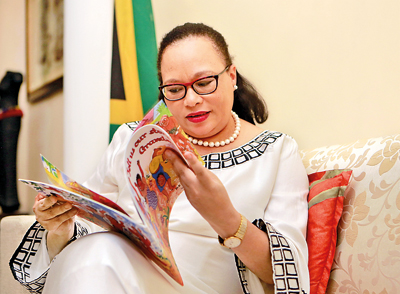An envoy’s quest to regain dignity for Lanka’s African community

South African High Commissioner Robina Marks
The Afro-Lankan community is scattered across the island, mainly in Puttalam but also in pockets of Matara, Negombo and Batticaloa. Altogether there are some 350 families. Descendants of about 15,000 individuals brought in by colonisers, they are known as ‘Kaffirs’.
When Robina P. Marks first heard the word she was aghast. At home it would have been a serious offence that would have led to imprisonment. She enlightened the community that the term was a racial slur and its Sinhalese equivalent- Kapiri- carried very derogatory connotations.
This experience was one of the many that pushed Robina, currently High Commissioner for South Africa in Sri Lanka, to pen “Tell us our story, Grandma”, a children’s book that has the distinction of being renowned artist Sybil Wettasinghe’s last work as illustrator.
Robina herself has a rich cultural heritage. Her father comes from the Xhosa people (the people of Nelson Mandela), but her mother is Khoi- which makes her a true child of the land- for these include the Bushmen who are the oldest of peoples in Africa.
The book, launched on June 30, narrates how the Africans came to Sri Lanka. “It is not my story,” says Robina. It was the tale she heard from young Afro-Lankans when she visited them and gathered them around her- of how their ancestors came in great slave ships to Serendib.
These Afro-Lankans still hold dear an oral tradition from the old continent, which helps them to hold on to a unique cuisine, culture and music.
Published in English, Sinhala and Tamil, the book is an attempt to recognize and honour a community brought here as slaves, against their will, and helped build Sri Lanka.
The book conjures a verdant Africa (though many would have come from the drier savanna) and how they settled down here. It is full of the ebullience and lively joy that ‘Aunty Sybil’ so effortlessly creates.
But behind the delight lies a grim story- one of colonialism and forced labour. Robina insists that we look at the trauma caused by colonialism full in the face.
Despite claims that the Europeans developed infrastructure, this was at a massive cost to the natives- as witnessed by the heavy taxes imposed on the Ceylonese.
Once, driving into the Galle Fort, Robina was deeply moved to hear that the large car park by the ramparts was built on a place where many slaves were buried. It felt as if her ‘soul was being crushed’- for Africans never walk on graves and not to acknowledge a burial site was a serious breach.
She also visited the Moon Bastion dungeons near the lighthouse where the slaves were kept shackled.
“There you feel a heavy sadness- speaking of the pain and the enormity of the sadness and torture of men and women brought forcefully from home.”
So that those ancestors could rest in peace, Robina organized to burn sage in the dungeons- a ritual of consecration- like the Christian ritual of sprinkling holy water.
“We said to them that ‘we acknowledge you, we honour you, we see you- we have not forgotten you, but you can now rest in peace’.
“And I could feel a sense of sadness being lifted.”
Sybil pairing up with Robina for the book happened quite accidentally. Visiting Sybil (whom Robina had long admired for her work) Robina had mentioned her book and Sybil exclaimed that she would very much love to draw for the project.
Robina- though tempted- could not agree to foist work on the 92-year-old artist.
But Sybil would insist and later confided that her enthusiasm for the project sprang from a childhood experience, where her friends would shun her for being dark, calling her ‘kalu’. She wanted no child to be discriminated for the colour of their skin.
Sybil’s contribution went far beyond the writing. Robina got advice from her on some fine points in metaphors. At first glimpse the white men to the Africans were ‘the colour of yams after they are peeled’.
As for the hair of the Sri Lankans when they first landed in the island, they looked ‘long and straight like coconut leaves’.
The book- Robina hopes- will strengthen ties between Sri Lanka and South Africa even more, while teaching Sri Lankans about this vibrant community from Africa.
While they today remain Sri Lankan, millennia of atavistic memory binds them to Africa. This is why Robina says that “through 400 years they have lost much but what hasn’t been lost is the yearning of the spirit to respond to the beat of Africa and where they come from.”
But finally, she has this to say on why we must dig up and address the trauma our ancestors- from Africa, Asia or America, went through as colonies:
“Because, (as one of the) interesting studies that have been done around the impact of colonialism says, that colonialism lives in the trauma and the DNA of succeeding generations- and until and unless you face the original trauma that had happened to your ancestors many, many, years ago, you will not understand why your life’s not ok.”
The book will not be sold, but will be distributed free of charge to all school libraries in Sri Lanka. It will also be available to be downloaded free.


